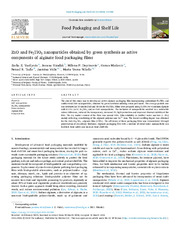Prikaz osnovnih podataka o dokumentu
ZnO and Fe2TiO5 Nanoparticles Obtained by Green Synthesis as Active Components of Alginate Food Packaging Films
| dc.creator | Vasiljević, Zorka Z | |
| dc.creator | Vunduk, Jovana | |
| dc.creator | Dojčinović, Milena | |
| dc.creator | Mišković, Goran | |
| dc.creator | Tadic, Nenad | |
| dc.creator | Vidic, Jasmina | |
| dc.creator | Nikolić, Maria Vesna | |
| dc.date.accessioned | 2024-04-08T09:28:22Z | |
| dc.date.available | 2024-04-08T09:28:22Z | |
| dc.date.issued | 2024 | |
| dc.identifier.issn | 2214-2894 | |
| dc.identifier.uri | http://rimsi.imsi.bg.ac.rs/handle/123456789/3190 | |
| dc.description.abstract | In this paper, we have systematically studied the structural, morphological, and optical properties of Ni-doped TiO2, synthesized via a simple, cost-effective electrospinning method followed by calcination at 500 C. The nanofibers with a core-shell structure were relatively homogeneous, smooth and randomly oriented, and there were no significant differences in fiber diameters due to Ni2+ content. Core loss mapping using electron energy loss spectroscopy confirmed an even distribution of titanium and relatively uniform nickel in the fibers. It was found that doping with 0.5 mol.% Ni2+ decreased the rutile content, while doping with 1 mol.% Ni2+ resulted in a pure anatase phase with a significantly increased specific surface area (36.6 m2/g). Further increase in Ni2+ content (3-10 mol.%) not only prolonged the response of TiO2 nanofibers to visible light, but also increased the specific surface area (49.5 m2/g), decreased crystallite size (7 nm), and increased rutile content in TiO2 (33 wt.%). Photoluminescence analysis revealed that doping TiO2 with different amounts of Ni2+ leads to a gradual decrease of emission spectra intensity and red shift in the maxima positions. The XPS results confirmed that as the Ni2+ content enlarged, the Ti2+ and Ti3+ content increased significantly, effectively promoting the formation of oxygen vacancies. Raman analysis showed that an increase in nickel content (3-5 mol.%) led to a decrease and shift in peak intensity due to Ti3+ formation and also the possible presence of NiTiO3 phases. HRTEM analysis showed that Ni was doped into the substitution sites of both the anatase and rutile TiO2 lattice but had a stronger influence on the distortion of the anatase phase. The obtained results indicate that Ni-doped TiO2 nanofibers are good candidates for photocatalytic applications. | sr |
| dc.language.iso | en | sr |
| dc.publisher | Elsevier | sr |
| dc.relation | info:eu-repo/grantAgreement/MESTD/inst-2020/200053/RS// IMSI | sr |
| dc.relation | info:eu-repo/grantAgreement/MESTD/inst-2020/200051/RS// IOFH | sr |
| dc.rights | openAccess | sr |
| dc.rights.uri | https://creativecommons.org/licenses/by/4.0/ | |
| dc.source | Food Packaging and Shelf Life | sr |
| dc.subject | ZnO nanoparticles / Fe2TiO5 nanoparticles / Green synthesis / Alginate film / Composite film | sr |
| dc.title | ZnO and Fe2TiO5 Nanoparticles Obtained by Green Synthesis as Active Components of Alginate Food Packaging Films | sr |
| dc.type | article | sr |
| dc.rights.license | BY | sr |
| dc.rights.holder | Elsevier | sr |
| dc.citation.spage | 101280 | |
| dc.citation.volume | 43 | |
| dc.identifier.doi | 10.1016/j.fpsl.2024.101280 | |
| dc.identifier.fulltext | http://rimsi.imsi.bg.ac.rs/bitstream/id/8572/1-s2.0-S2214289424000450-main.pdf | |
| dc.type.version | publishedVersion | sr |

